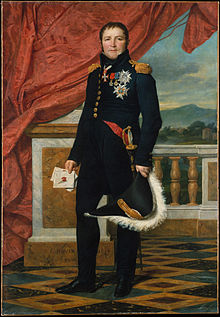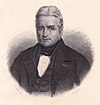Étienne Maurice Gérard
Étienne Maurice Gérard | |
|---|---|
 | |
| Prime Minister of France | |
| In office 18 July 1834 – 10 November 1834 | |
| Monarch | Louis Philippe I |
| Preceded by | Jean-de-Dieu Soult |
| Succeeded by | Hugues-Bernard Maret |
| Personal details | |
| Born | 4 April 1773 Damvillers, Kingdom of France (modern-day France) |
| Died | 17 April 1852 (aged 79) Paris, French Empire |
| Awards | Legion of Honor (Grand Cross) |
| Military service | |
| Allegiance | |
| Rank | Marshal of France |
| Battles/wars | French Revolutionary Wars Napoleonic Wars Belgian Revolution |
Étienne Maurice Gérard, 1st Comte Gérard (French: [etjɛn mɔʁis ʒeʁaʁ]; 4 April 1773 – 17 April 1852) was a distinguished French general and statesman. He served under a succession of French governments including the ancien regime monarchy, the Revolutionary governments, the Restorations, the July Monarchy, the First and Second Republics, and the First Empire (and arguably the Second),[1] becoming prime minister briefly in 1834.
Biography
[edit]Early life and career
[edit]Born as the son of a royal bailiff at Damvillers, in Lorraine, Gérard joined a battalion of volunteers in 1791, and served in the campaigns of 1792–1793 under Generals Charles François Dumouriez and Jean-Baptiste Jourdan. He first saw real action fighting at the defiles of Argonne and then at Jemappes where his conspicuous bravery earned him promotion to second lieutenant and he was promoted again following his actions at Neerwinden. In the summer of 1794, Gérard joined the 71st demi-brigade and fought at the Battle of Fleurus and then at the capture of Charleroi and Aldenhoven where he rushed through enemy lines to establish a rope across the river to allow the troops to cross the Roer. In 1795, he served Jean-Baptiste Bernadotte as aide-de-camp and the two formed a close friendship. Gérard then followed Bernadotte to Italy where he served under Napoleon's command for the first time and was promoted to captain for his actions at Valvasone. In 1799 he fought in Switzerland under the command of André Masséna and he was promoted chef d'escadron, and in 1800 colonel.[1]
Rise to prominence
[edit]As the Grande Armée marched to war in 1805, Gérard served as first aide-de-camp to Bernadotte and greatly distinguished himself at the battle of Austerlitz where he charged at the head of the French squadrons against the Russian Imperial Guard and was wounded by grapeshot to the thigh. During the war against Prussia in 1806, he fought at Schleiz, Halle, Lübeck and was made Brigadier General in November 1806. Gérard was given command of a brigade in VII Corps which was engaged at Mohrungen and Eylau in early 1807. A month after Eylau, he was transferred to command of 2nd brigade in I Corps which took part in the campaign that June and saw action at Guttstadt-Deppen. When the War of the Fifth Coalition broke out, Gérard was given command of the Saxon cavalry in Bernadotte's IX Corps and was so praised for his gallant conduct in the battle of Wagram that he was created a baron of the First French Empire.[1]
In the Spanish campaign of 1810 and 1811, Gérard gained special distinction at the Battle of Fuentes de Oñoro; and in the expedition to Russia he fought at the battle of Smolensk and the battle of Valutino, and displayed such bravery and ability in the battle of Borodino that he was made général de division. He won further distinction in the disastrous retreat from Moscow, fighting at Maloyaroslavets, Krasnoi and with the rearguard at Berezina and Kowno. [1]
Campaigns of 1813–1814
[edit]In the campaign of 1813, in command of a division, he took part in the battle of Lützen and at the battle of Bautzen where he was placed in front of the Spree, so as to link up with corps of the extreme right. After ferocious combat, this corps was forced to retreat. Macdonald, judging that this development compromised his vanguard commanded by Gérard, sent him the order to retreat "on the contrary" replied Gérard to the bearer of the order, "instead of withdrawing, we must advance and I will answer for the success of the day". He then gave orders to attack and the positions were retaken. Gérard continued to serve with Macdonald during his independent operations, at Goldberg he repeated what he had done at Bautzen, ignoring orders to retreat and launching an assault that put the enemy to rout. He then fought at the battle of Leipzig (in which he commanded the XI Corps) where he was gravely wounded. After the battle of Bautzen, he was created by Napoleon a count of the Empire. In the Campaign in north-east France (1814), he proved to be one of Napoleon's most capable and energetic subordinates. Gérard prepared Phalsbourg for defense then took command of a division in II Corps which fought at Brienne and then La Rothière where Gérard demonstrated superb defensive skill by repelling a series of attacks from numerically superior coalition forces on the French right flank. He won still greater distinction at Mormant and Montereau, in which he took over command of II Corps from Marshal Victor. During the final phase of the campaign, Gérard continued to distinguish himself, winning at the bridge of Guillotière, putting himself in the thick of the action at a skirmish around Vendeuvre and fighting with his corps at Saint-Dizier.
Restoration, Hundred Days and July Revolution
[edit]After the first Bourbon Restoration, he was named by King Louis XVIII Grand Cross of the Legion of Honor and chevalier of St Louis.[1]
During the Hundred Days, Napoleon made Gérard a Peer of France and placed him in command of the IV Corps of the Army of the North. In this capacity Gérard took a brilliant part in the battle of Ligny, and on the morning of 18 June he was foremost in advising Marshal Grouchy to march to the sound of the guns to aid the emperor at Waterloo. Having failed in this he took part in the battle of Wavre.[1]
Gérard retired to Brussels after the fall of Napoleon, and did not return to France until 1817. He sat as a member of the Restoration's Chamber of Deputies in 1822–1824, and was re-elected in 1827.[1]
Serving as a voice of moderation in the midst of political chaos, Gérard played an active role during the July Revolution of 1830, after which he was appointed minister of war and named a Marshal of France. On account of his health he resigned the office of War Minister in the following October.[1]
Belgian campaign and later distinctions
[edit]
However, in 1831 he took the command of the Northern Army, and was successful in forcing the army of the Netherlands to withdraw from Belgium (see Belgian Revolution). In 1832 he commanded the besieging army in the famous siege of the citadel of Antwerp.[1] Gérard was awarded a special ceremonial sword by the grateful Belgians in recognition of his triumph.
He was again chosen war minister in July 1834,[1] and served as Prime Minister of the July Monarchy,[2] but resigned in the following October. In 1836 he was named grand chancellor of the Legion of Honour in succession to Marshal Mortier, and in 1838 commander of the National Guards of the Seine département, an office which he held until 1842. He became a senator of the Second Empire in 1852 (before it was formally instituted), and died in the same year, aged 79.[1]
Marriage and descendants
[edit]Gérard married Rosemonde de Valence in 1816. Their granddaughter was Rosemonde Gérard.[2]
Notes
[edit]- ^ The portrait is done in 1816, by Jacques-Louis David. Now on display in Metropolitan Museum of Art, New York
References
[edit]- This article incorporates text from a publication now in the public domain: Chisholm, Hugh, ed. (1911). "Gérard, Étienne Maurice". Encyclopædia Britannica. Vol. 11 (11th ed.). Cambridge University Press. p. 764.
- 1773 births
- 1852 deaths
- People from Meuse (department)
- Counts of the First French Empire
- Politicians from Grand Est
- Prime ministers of France
- Ministers of war of France
- Members of the Chamber of Peers of the Hundred Days
- Members of the Chamber of Deputies of the Bourbon Restoration
- Members of the 1st Chamber of Deputies of the July Monarchy
- Members of the 2nd Chamber of Deputies of the July Monarchy
- Members of the Chamber of Peers of the July Monarchy
- French senators of the Second Empire
- Marshals of France
- French military personnel of the French Revolutionary Wars
- French commanders of the Napoleonic Wars
- People of the Belgian Revolution
- Grand Cross of the Legion of Honour
- Grand Chancellors of the Legion of Honour
- Names inscribed under the Arc de Triomphe




